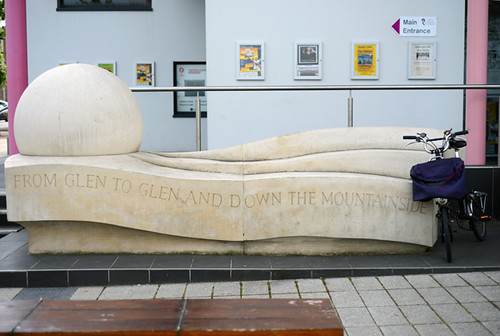
When we moved to the US in the early '90s, I promptly started junior high school in a small New England town. The first thing I remember about walking into the classroom, was the shock of green cardboard shamrocks strung up all over the walls and a large banner declaring "Erin Go Bragh." (
That's not how you spell it, a friend from Cork would later wrinkle her nose. But never mind.) Our teacher was fiercely Irish, as were at least half of the students. Second or third generation mainly, and, truth be told, most of them ethnically mixed. But Irish identities had a way of dominating in those days - when the economic boom had not yet hit the Emerald Isle, when South Boston still had romantic notoriety, and when House of Pain's Jump Around played several times a day on MTV.Most chose to express this identity through visual iconology: shamrocks, leprechauns, bright kelly green, friendship rings, and abundant use of faux-celtic fonts. But soon fate brought the opportunity to also express it musically.
In those days, our school had a rather famous
a cappellachoir, led by our passionate and popular music teacher, Mr. McKenna. It wasn't just anyone who could join this elite group. There were limited spots. The annual tryouts involved weeks of preparation from hopefuls and bitter tears from those who did not make it. But those of us who made it... my goodness, we felt special. In the mornings, we went to choir practice instead of home room.We wore beautiful uniforms.We stood side by side, in a tight formation on metal risers. Labeled a strong Soprano, I still remember my place: 3rd row, 5th from the right. Our choir recorded albums. Our choir preformed in competitions and won. Once a year we even travelled to compete in the national finals, inevitably returning with medals.
We were one of the best, Mr. McKenna would tell us, again and again, beaming at our fresh-scrubbed teenage faces, our teary eyes and our chapped lips from hours of singing. And we were one of the best because we worked at it. Because we rehearsed until each piece was perfect. And if it wasn't perfect (his face would turn serious now, almost stormy), we did not perform it. Not at a local Christmas concert, and certainly not at competition. Was that understood by each and every one of us? It was.
The national finals happened in May. Competing choirs would select their performance pieces in September, then spend the entire school year rehearsing them. The year I entered the 8th grade, Mr. McKenna gathered us to announce the competition selection with an air of festivity: For our main piece, we would be singing Danny Boy. As he distributed the sheet music, it was clear that the piece was very, very dear to him.
With tears in his eyes, Mr. McKenna talked about Ireland. How beautiful it was and how special his visit there with his wife and children had been - a place where his great grandfather had once lived and farmed.Later, as we struggled with the song, he talked about visualising the glens and imagining Danny Boy's plight. We tried our best, although most of us did not know what glens were exactly.
It was a beautiful, but complicated piece. Or maybe the arrangement Mr. McKenna had chosen was complicated, his judgment clouded by a reverence for the song's Irishness. Overly nuanced harmonies, notes held too long for our young lungs, sharp transitions from low notes to high. We were a good choir, but we were amateurs. We were a motivated bunch of kids, but we only had so much energy to give, after our classes and homework and turbulent teenage love-lives.
In fairness, we were doing fine with Danny Boy. We were getting there. But for Mr. McKenna's liking, we were not getting there fast enough. So he panicked, and he pushed us. With passionate pep talks and hours of extra rehearsals, he pushed and he pushed. He pushed until the melody of Danny Boy began to sound like nails against a chalkboard to our ears. He pushed until the lyrics lost all meaning and each repetition felt like a seizure-induced loop. He pushed until, instead of inspiring a breakthrough, Mr. McKenna broke our spirits.
Having come down with the flu, I did not join the choir in that year's finals. I did not witness the mass hysteria and weeping after, for the first time in its 12 year history, our choir failed to earn a medal at the competition. I only saw my peers' dejected faces when they returned home empty handed. I only saw the careless wrinkles in their uniforms at our next local performance and the way they slouched on the risers, with Mr. McKenna not bothering to chide us for either transgression.
We never talked about it. But deep down we all connected our choir's fall from grace with this attempt at a perfect rendition of Danny Boy. The piece was simply too personal, too precious for Mr. McKenna; he gave in to the rawness of his emotions and lost perspective. The following year, when I was already in high school, we heard that Mr. McKenna stepped down as music teacher and moved away. We were told he had health problems, and there were whispers of a nervous breakdown. It was not until years later that we learned he divorced his wife of 30 years and married one of his former students (by then a high school graduate, aged 19), which prompted parents to call for his resignation.
I have not thought about any of this in years. But I think about it now, in the mornings, as I lock up my bike in the town center of Limavady, Northern Ireland. There is a contemporary sculpture next to the cafe where I like to work. It is vaguely glen-shaped, in an abstract sort of way, and engraved with the lyrics to Danny Boy. Across the street is the colourful Corner Bar, its walls painted with murals containing more references to the song. And a helpful inscription explains the connection: "It was in Limavady that the famous melody 'Danny Boy' was noted down by Jane Ross from a tune played by a blind street fiddler named Jimmy McCurry." The original name of the melody was actually Londonderry Air, written byEnglishman Frederic Weatherly. But never mind. It's been 20 years since I sang Danny Boy and I still remember the lyrics.















 Harry, Sophia, Maude, William, and Maurice. Hazlette, seated in front.
Harry, Sophia, Maude, William, and Maurice. Hazlette, seated in front.




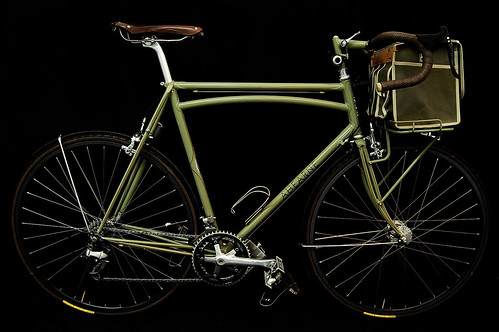





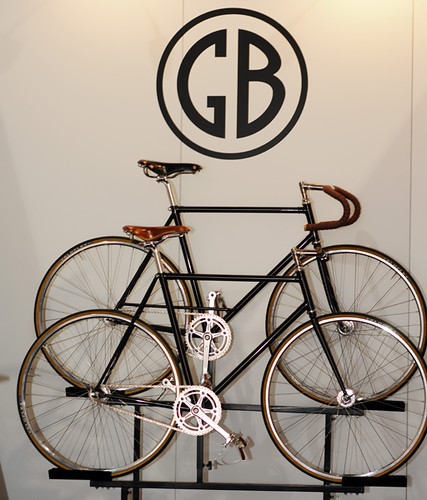 One of the things I was truly excited to see at Interbike was the GB display. GB Components (the initials stand for the founder Gerry Burgess) are known to vintage bicycle lovers, particularly the handlebars. Well, the company is now re-establishing itself under the ownership of the original founder's son (Jeremy Burgess), and the prototypes of their new, made in the UK components were modestly on display.
One of the things I was truly excited to see at Interbike was the GB display. GB Components (the initials stand for the founder Gerry Burgess) are known to vintage bicycle lovers, particularly the handlebars. Well, the company is now re-establishing itself under the ownership of the original founder's son (Jeremy Burgess), and the prototypes of their new, made in the UK components were modestly on display. 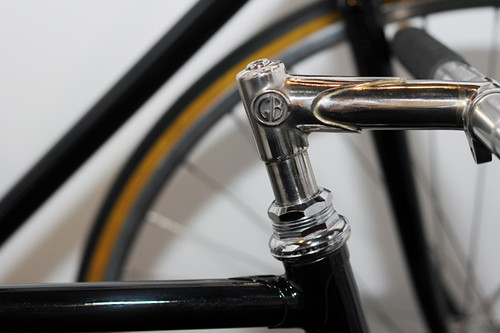 These include a gorgeous lugged stem (both quill and threadless models),
These include a gorgeous lugged stem (both quill and threadless models), sculptural-looking wingnuts, handlebars, and other components. I have more photos that I will include in my big Interbike write-up, but these should give you an idea of their beauty. I spoke with the GB representative for a while, and may get to review some of the components as they go into production - will keep you posted.
sculptural-looking wingnuts, handlebars, and other components. I have more photos that I will include in my big Interbike write-up, but these should give you an idea of their beauty. I spoke with the GB representative for a while, and may get to review some of the components as they go into production - will keep you posted. In the meantime, I would like to give you their cycling cap. These were being given away as promotional items at Interbike, and they are rather nice.
In the meantime, I would like to give you their cycling cap. These were being given away as promotional items at Interbike, and they are rather nice. The cap is white summer-weight cotton, with a single black ribbon stripe and an embroidered GB logo on the underside of the visor. The crown is rounded. The size is what I would call a Medium.
The cap is white summer-weight cotton, with a single black ribbon stripe and an embroidered GB logo on the underside of the visor. The crown is rounded. The size is what I would call a Medium. 








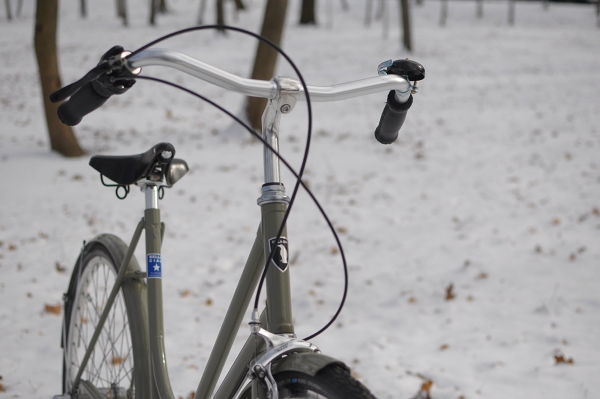 Some readers notice that I always have the front brake lever set up on the right handlebar on my bikes and ask me why, since the opposite arrangement is more typical in the US. The quick answer is that I find the "right front" setup more intuitive and more convenient. I have owned bikes with both "left front" and "right front" setups, and consistently began to notice that I prefer to have the front brake lever on the right handlebar. So at some point we rerouted all of my bikes to have the front brake on the right side, and I've been happy since.
Some readers notice that I always have the front brake lever set up on the right handlebar on my bikes and ask me why, since the opposite arrangement is more typical in the US. The quick answer is that I find the "right front" setup more intuitive and more convenient. I have owned bikes with both "left front" and "right front" setups, and consistently began to notice that I prefer to have the front brake lever on the right handlebar. So at some point we rerouted all of my bikes to have the front brake on the right side, and I've been happy since.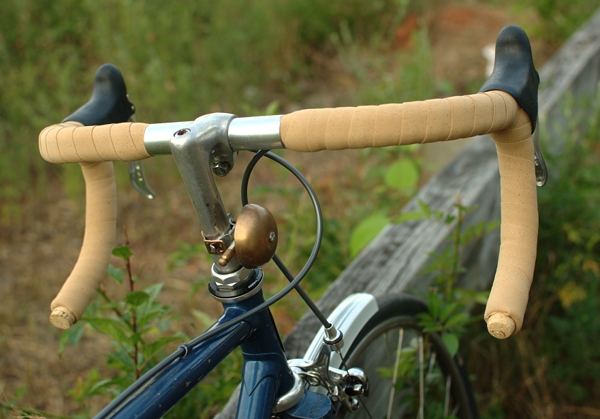 Some reasons why I prefer the "right front" set-up:
Some reasons why I prefer the "right front" set-up: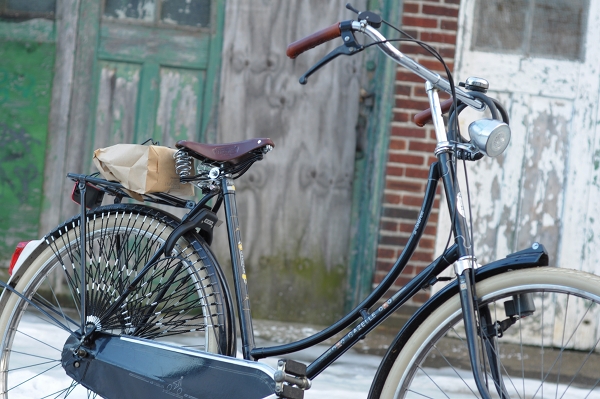 There are different views out there regarding which set-up makes the most sense, and Sheldon Brown has a nice write-up about it here. Ultimately, I think it is up to the individual cyclist to determine which feels more natural to them. And if the setup with which your bike came from the store doesn't feel right, be aware that this is something that can easily be changed by re-routing the brake cables.
There are different views out there regarding which set-up makes the most sense, and Sheldon Brown has a nice write-up about it here. Ultimately, I think it is up to the individual cyclist to determine which feels more natural to them. And if the setup with which your bike came from the store doesn't feel right, be aware that this is something that can easily be changed by re-routing the brake cables.
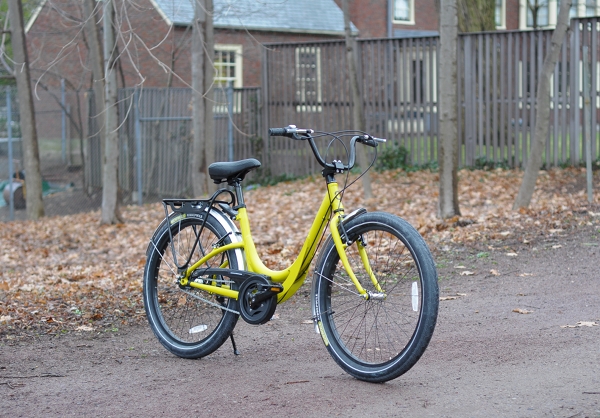 The past couple of days were rainy and dreary, and I've been sick in bed. Still, I managed to crawl to the door when the bell rang, and take delivery of an enormous package from Urbana Bikes - a Canadian manufacturer that has asked me to review this unusual creation. I opened the box and nearly jumped back from the burst of colour that greeted me. I'd requested a bike in "olive," which on the manufacturer's website looks like this. In person it resembles an exotic poisonous mushroom. "Oh boy, I should have asked for black!" was my initial thought. But as I continued to stare, the neon shade began to grow on me. At least it offered a cheerful contrast to the dark gray skies and pelting rain outside. I dragged the bike outdoors for some quick snapshots, half-hoping the rain would mistake it for the sun and stop... and believe it or not, it did, if only for a few minutes.
The past couple of days were rainy and dreary, and I've been sick in bed. Still, I managed to crawl to the door when the bell rang, and take delivery of an enormous package from Urbana Bikes - a Canadian manufacturer that has asked me to review this unusual creation. I opened the box and nearly jumped back from the burst of colour that greeted me. I'd requested a bike in "olive," which on the manufacturer's website looks like this. In person it resembles an exotic poisonous mushroom. "Oh boy, I should have asked for black!" was my initial thought. But as I continued to stare, the neon shade began to grow on me. At least it offered a cheerful contrast to the dark gray skies and pelting rain outside. I dragged the bike outdoors for some quick snapshots, half-hoping the rain would mistake it for the sun and stop... and believe it or not, it did, if only for a few minutes. The Urbana bicycle is a rather extraordinary cross between a BMX bike, a mountain bike, and a Dutch transport bike with large hauling capacity. But I will elaborate on all of that once it's time to review it. What struck me today, was how remarkably vibrant the "poisonous mushroom" colour looked in rainy weather. I walked away from the bike, stood to the side, turned around partially - but as long as it was even peripherally in my field of vision, it commanded attention. I look forward to comparing my experience in traffic on this "hi-vis" bicycle, to my own, neutrally coloured bikes.
The Urbana bicycle is a rather extraordinary cross between a BMX bike, a mountain bike, and a Dutch transport bike with large hauling capacity. But I will elaborate on all of that once it's time to review it. What struck me today, was how remarkably vibrant the "poisonous mushroom" colour looked in rainy weather. I walked away from the bike, stood to the side, turned around partially - but as long as it was even peripherally in my field of vision, it commanded attention. I look forward to comparing my experience in traffic on this "hi-vis" bicycle, to my own, neutrally coloured bikes.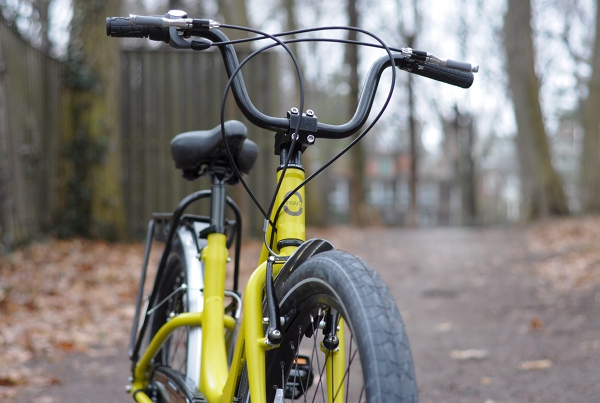 We are still in the process of adjusting the bike's components and I was not in a condition to cycle yesterday anyhow, but I will share my impressions once I begin to ride it. This is the first time I'll be reviewing a bicycle that isn't mine beyond a single test ride, so it should be interesting. I am still ironing out the logistics with the manufacturer, but after my review the Urbana will go to a new home.
We are still in the process of adjusting the bike's components and I was not in a condition to cycle yesterday anyhow, but I will share my impressions once I begin to ride it. This is the first time I'll be reviewing a bicycle that isn't mine beyond a single test ride, so it should be interesting. I am still ironing out the logistics with the manufacturer, but after my review the Urbana will go to a new home. Normally I am not a fan of hi-vis anything, but I make an exception in inclement weather and I think that neon bicycles would make good "rainbikes."How many of you ride brightly coloured bikes - either because you prefer the colours, or for the sake of visibility? And do any of you have dedicated rainbikes?
Normally I am not a fan of hi-vis anything, but I make an exception in inclement weather and I think that neon bicycles would make good "rainbikes."How many of you ride brightly coloured bikes - either because you prefer the colours, or for the sake of visibility? And do any of you have dedicated rainbikes?













